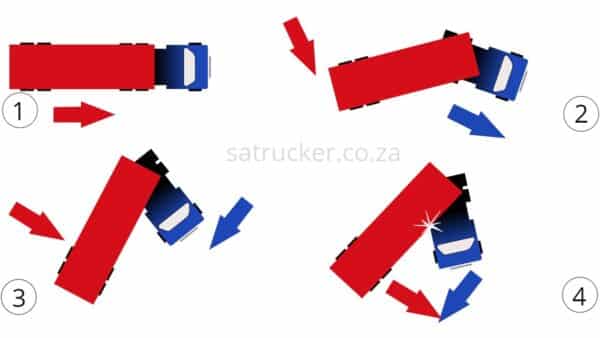
A jackknifed truck and trailer
A jackknife situation is one of the most harrowing experiences a truck driver can face on the road. It occurs when the trailer of a truck swings out of control, resembling the motion of a folding pocket knife.
This can happen due to various factors such as slippery roads, sudden manoeuvres, or improper braking. I previously wrote an article about the causes of a truck jackknife, you can read more about this on the highlighted link.

Handling a jackknife requires quick thinking, precise actions, and a clear understanding of the vehicle’s dynamics.
In this comprehensive step-by-step guide, we will outline a chronological sequence of actions that drivers can take to safely navigate and recover from a truck jackknife situation. If these steps are actioned within the first 12 seconds of a jackknife, the trucker stands a great chance to regain control and avoid catastrophe.
Stay Calm and Assess the Situation (Time: 0-2 seconds)
- As soon as you realize that the truck is jackknifing, stay calm and focused.
- Assess the severity of the situation by looking at the angle between the truck and the trailer.
- Determine the cause of the jackknife, whether it’s slippery road conditions, abrupt steering, or sudden braking.
Take Your Foot Off the Accelerator or Brakes (Time: 2-3 seconds)
- If you haven’t already, release the brakes immediately or take your foot off the accelerator to reduce speed and prevent further instability.
- Braking or accelerating while in a jackknife situation can exacerbate the problem by locking up the wheels and causing the trailer to swing even further out of control.
Counter-Steer Against Jackknife Direction (Time: 2-3 seconds)
- Gently turn the steering wheel in the opposite direction of the jackknife to counteract the motion.
- Instead of steering directly into the skid, focus on straightening out the truck and trailer alignment.
- Turn the steering wheel gradually in the direction that helps align the truck and trailer, aiming to reduce the angle between them.
Accelerate or Decelerate Appropriately (Time 3-5 seconds)
- Depending on the situation, you may need to either accelerate or decelerate to regain control.
- Accelerating can help straighten out the truck and trailer if there’s enough space ahead and traction allows.
- Decelerating gently may also help in some cases, but avoid harsh braking.
Control Your Speed (5-6 seconds)
- Maintain a safe and controlled speed throughout the manoeuvre.
- Avoid sudden changes in speed or direction, as these can aggravate the jackknife.
Use Trailer Brakes (if available)(7-9 seconds)
- If your truck is equipped with trailer brakes, apply them cautiously.
- Trailer brakes can help stabilize the trailer and prevent it from swinging further.
Aim for an Open Space (9-10 seconds)
- If possible, manoeuvre the truck and trailer towards an open space, such as the shoulder of the road or an empty parking lot.
- Try to avoid obstacles such as other vehicles, guardrails, or roadside structures
Prepare for Impact (if necessary) (10-12 seconds)
- In extreme cases where recovery is not possible, prepare for impact.
- Brace yourself by firmly gripping the steering wheel and positioning your feet away from the pedals to minimize injury.
Handling a truck jackknife requires quick thinking, decisive actions, and a cool head under pressure. By following the chronological sequence of actions outlined in this guide, drivers can improve their chances of safely recovering from a jackknife situation and minimizing damage to themselves, their vehicles, and others on the road.
However, prevention is always the best approach, so drivers should also undergo regular training, practice defensive driving techniques, and maintain their vehicles in optimal condition to reduce the risk of jackknifing incidents.
How to Handle a Truck Jackknife: A Step-by-Step Guide for Drivers – 12 seconds
Stay Calm and Assess the Situation
As soon as you realize that the truck is jackknifing, stay calm and focused.
Assess the severity of the situation by looking at the angle between the truck and the trailer.
Determine the cause of the jackknife, whether it’s slippery road conditions, abrupt steering, or sudden braking.Take Your Foot Off the Accelerator or Brakes
If you haven’t already, release the brakes immediately or take your foot off the accelerator to reduce speed and prevent further instability.
Braking or accelerating while in a jackknife situation can exacerbate the problem by locking up the wheels and causing the trailer to swing even further out of control.Counter-Steer Against Jackknife Direction
Gently turn the steering wheel in the opposite direction of the jackknife to counteract the motion.
Instead of steering directly into the skid, focus on straightening out the truck and trailer alignment.
Turn the steering wheel gradually in the direction that helps align the truck and trailer, aiming to reduce the angle between them.Accelerate or Decelerate Appropriately
Depending on the situation, you may need to either accelerate or decelerate to regain control.
Accelerating can help straighten out the truck and trailer if there’s enough space ahead and traction allows.
Decelerating gently may also help in some cases, but avoid harsh braking.Control Your Speed
Maintain a safe and controlled speed throughout the manoeuvre.
Avoid sudden changes in speed or direction, as these can aggravate the jackknife.Use Trailer Brakes (if available)
If your truck is equipped with trailer brakes, apply them cautiously.
Trailer brakes can help stabilize the trailer and prevent it from swinging further.Aim for an Open Space
If possible, manoeuvre the truck and trailer towards an open space, such as the shoulder of the road or an empty parking lot.
Try to avoid obstacles such as other vehicles, guardrails, or roadside structuresPrepare for Impact (if necessary)
In extreme cases where recovery is not possible, prepare for impact.
Brace yourself by firmly gripping the steering wheel and positioning your feet away from the pedals to minimize injury.
What should I do if my truck starts to jackknife?
Release brakes, straighten alignment, control speed, and aim for open space to manoeuvre safely.
Can I prevent a truck jackknife from happening?
Yes, maintain vehicle, practice defensive driving, and anticipate hazards to reduce risks.







